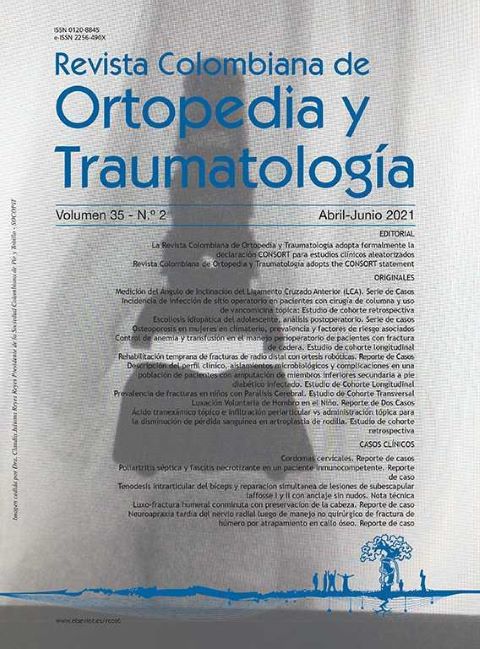Cordomas cervicales. Reporte de casos
DOI:
https://doi.org/10.1016/j.rccot.2021.02.011Palabras clave:
cordoma, tumor, columna cervical, tratamientoResumen
Introducción: La detección temprana del cordoma constituye un desafío médico dada su baja frecuencia, calculada entre 2-4% de todos los tumores primarios del hueso, requiriendo un alto índice de sospecha clínica. El diagnóstico tardío incrementa la morbimortalidad y compromete la sobrevida del paciente, por lo que el conocimiento actualizado sobre su etiopatogenia, clínica y tratamiento es de suma importancia para el cirujano espinal, quien forma parte esencial del grupo interdisciplinario terapéutico.
Reporte de casos: Reportamos dos casos de cordomas cervicales, localmente agresivos sin extensión sistémica, el primero de ellos ubicado en la columna cervical y el segundo en la unión craneocervical. Ambos con diferentes formas de presentación, síntomas, tiempo de evolución (5 años y 7 meses respectivamente), infiltración tumoral y abordaje quirúrgico, pero similar tratamiento oncológico. El objetivo del manuscrito es demostrar la variedad de presentación cervical de la entidad y las diferentes formas de abordarla. Se incluye una revisión actualizada de la literatura donde se evidencia la importancia de la inmunoterapia como nuevo horizonte terapéutico, y se reafirma la resección quirúrgica como base del mismo.
Discusión: Se presentan los resultados imagenológicos de descompresión medular, resección ósea y de partes blandas, los tipos de fijación espinal y la evolución clínica, sin recidiva local a los 2 años y a los 12 meses respectivamente en cada caso, luego del manejo quirúrgico y la radioterapia adyuvante.
Nivel de evidencia: IV
Descargas
Referencias bibliográficas
Walcott BP, Nahed BV, Mohyeldin A, et al. Chordoma: Current concepts, management, and future directions. Lancet Oncol. 2012;13:e69-76. https://doi.org/10.1016/S1470-2045(11)70337-0
Sciubba DM, Chi JH, Rhines LD, Gokaslan ZL:. Chordoma of the spinal column. Neurosurg Clin N Am. 2008;19:5-15. https://doi.org/10.1016/j.nec.2007.09.006
S. H. Bakker. Chordoma: a systematic review of the epidemiology and clinical prognostic factors predicting progression-free and overall survival. European Spine Journal. 27(12):3043-3058 https://doi.org/10.1007/s00586-018-5764-0
Terahara A, Niemierko A, Goitein M, Finkelstein D, Hug E, Liebsch N, O'Farrell D, Lyons S, Munzenrider J. Analysis of the relationship between tumor dose inhomogeneity and local control in patients with skull base chordoma. Int J Radiat Oncol Biol Phys. 1999;45:351-8. https://doi.org/10.1016/S0360-3016(99)00146-7
Vujovic S, Henderson S, Presneau N, et al. Brachyury, a crucial regulator of notochordal development, is a novel biomarker for chordomas. J Pathol. 2006;209:157-65. https://doi.org/10.1002/path.1969
Virchow RL. Untersuchungen ueber die Entwicklung des Schaedelgrundes. Berlin: G Rimer; 1857.
Ribbert H. Uber die Ecchondosis physaliphora sphenooccipitalis. Centralbl Allg Pathol Anat. 1894;5:457-61.
Boriani S, Chevalley F, Weinstein JN, et al. Chordoma of the spine above sacrum. Treatment and outcome in 21 cases. Spine. 1996;21:1569-77. https://doi.org/10.1097/00007632-199607010-00017
York JE, Kaczaraj A, Abi-Said D, et al. Sacral chordoma: 40-year experience at a major cancer center. Neurosurgery. 1999;44:74-9. https://doi.org/10.1097/00006123-199901000-00041
Smoll NR, Gautschi OP, Radovanovic I, et al. Incidence and relative survival of chordomas: the standardized mortality ratio and the impact of chordomas on a population. Cancer. 2013;119:2029-37. https://doi.org/10.1002/cncr.28032
Dorfman H, Czerniak B. Bone Tumors. St. Louis: Mosby; 1998.
McMaster ML, Goldstein AM, Bromley CM, Ishibe N, Parry DM. Chordoma: incidence and survival patterns in the United States, 1973-1995. Cancer Causes Control. 2001;12:1-11. https://doi.org/10.1023/A:1008947301735
Healey JH, Lane JM:. Chordoma: A critical review of diagnosis and treatment. Orthop Clin North Am. 1989;20: 417-26.
Lau CS, Mahendraraj K, Ward A, Chamberlain RS. Pediatric chordomas: a population-based clinical outcome study involving 86 patients from the Surveillance, Epidemiology, and End Result (SEER) database. Pediatr Neurosurg. 2016;51: 127-36. https://doi.org/10.1159/000442990
McPherson CM, Suki D, McCutcheon IE, Gokaslan ZL, Rhines LD, Mendel E. Metastatic disease from spinal chordoma: A 10-year experience. J Neurosurg Spine. 2006;5:277-80. https://doi.org/10.3171/spi.2006.5.4.277
Mukherjee D, Chaichana KL, Adogwa O, et al. Association of extent of local tumor invasion and survival in patients with malignant primary osseous spinal neoplasms from the surveillance, epidemiology, and end results (SEER) database. World Neurosurg. 2011;76:580-5. https://doi.org/10.1016/j.wneu.2011.05.016
Smoll NR, Gautschi OP, Radovanovic I, et al. Incidence and relative survival of chordomas: the standardized mortality ratio and the impact of chordomas on a population. Cancer. 2013;119:2029-37. https://doi.org/10.1002/cncr.28032
Chambers KJ, Lin DT, Meier J, et al. Incidence and survival patterns of cranial chordoma in the United States. Laryngoscope. 2014;124:1097-102. https://doi.org/10.1002/lary.24420
Bergh P, Kindblom L-G, Gunterberg B, et al. Prognostic factors in chordoma of the sacrum and mobile spine. A study of 39 patients. Cancer. 2000;88:2122-34. https://doi.org/10.1002/(SICI)1097-0142(20000501)88:9<2122::AID-CNCR19>3.0.CO;2-1
Gui X, Siddiqui NH, Guo M. Physaliphorous cells in chordoma. '' Archives of Pathology & Laboratory Medicine. 2004;128:1457-8. https://doi.org/10.5858/2004-128-1457-PCIC
Babic MS. Development of the notochord in normal and malformed human embryos and fetuses''. International Journal of Developmental Biology. 1991;35:345-52.
Flanagan A, Yamaguchi T. Notochordal Tumors. En: Fletcher CDM, Bridge JA, Hogendoorn PC, Mertens F, editores. World Health Organization Classification of Tumours Pathology and Genetics of Tumours of Soft Tissue and Bone. 4th ed. Lyon: IARC Press; 2013. p. 326-69.
Hoch BL, Nielsen GP, Liebsch NJ, Rosenberg AE. Base of skull chordomas in children and adolescents: a clinicopathologic study of 73 cases. Am J Surg Pathol. 2006;30:811-8. https://doi.org/10.1097/01.pas.0000209828.39477.ab
Mou Z, Liu Z. Primary chordoma of the nose. '' Chinese Medical Journal. 2003;116:154-6.
Antonelli M, Raso A, Mascelli S, et al. SMARCB1/INI1 involvement in pediatric chordoma: a mutational and immunohistochemical analysis. Am J Surg Pathol. 2017;41:56-61. https://doi.org/10.1097/PAS.0000000000000741
Hanna SA, Tirabosco R, Amin A, et al. Dedifferentiated chordoma: a report of four cases arising ''de novo''. J Bone Joint Surg Br. 2008;90:652-6. https://doi.org/10.1302/0301-620X.90B5.20365
Barresi V, Ieni A, Branca G, Tuccari G. Brachyury: a diagnostic marker for the differential diagnosis of chordoma and hemangioblastoma versus neoplastic histological mimickers''. Dis Markers. 2014;2014:514753, https://doi.org/10.1155/2014/514753
Vujovic S, Henderson S, Presneau N, et al. Brachyury, a crucial regulator of notochordal development, is a novel biomarker for chordomas. J Pathol. 2006;209:157-65. https://doi.org/10.1002/path.1969
Soo MY. Chordoma: Review of clinicoradiological features and factors affecting survival. Australas Radiol. 2001;45:427-34. https://doi.org/10.1046/j.1440-1673.2001.00950.x
Khawaja AM, Venkatraman A, Mirza M. Clival chordoma: Case report and review of recent developments in surgical and adjuvant treatments. Pol J Radiol. 2017;82:670-5. https://doi.org/10.12659/PJR.902008
George B, Bresson D, Herman P, Froelich S. Chordomas: A Review. Neurosurg. Clin. N. Am. 2015 Jul;26:437-52. https://doi.org/10.1016/j.nec.2015.03.012
Disler DG, Miklic D. Imaging findings in tumors of the sacrum. AJR Am J Roentgenol. 1999;173:1699-706. https://doi.org/10.2214/ajr.173.6.10584822
Heery CR. Chordoma: The Quest for Better Treatment Options. Oncol Ther. 2016;4:35-51. https://doi.org/10.1007/s40487-016-0016-0
Bjornsson J, Wold LE, Ebersold MJ, Laws ER. Chordoma of the mobile spine. A clinicopathologic analysis of 40 patients. Cancer. 1993;71:735-40. https://doi.org/10.1002/1097-0142(19930201)71:3<735::AID-CNCR2820710314>3.0.CO;2-8
Fourney DR, Gokaslan ZL. Current management of sacral chordoma. Neurosurg Focus. 2003;15:9. https://doi.org/10.3171/foc.2003.15.2.9
Meyer JE, Lepke RA, Lindfors KK, Pagani JJ, Hirschy JC, Hayman LA, et al. Chordomas: Their CT appearance in the cervical, thoracic and lumbar spine. Radiology. 1984;153:693-6. https://doi.org/10.1148/radiology.153.3.6494465
Sciubba DM, Chi JH, Rhines LD, Gokaslan ZL. Chordoma of the spinal column. Neurosurg Clin N Am. 2008;19:5-15. https://doi.org/10.1016/j.nec.2007.09.006
Bohman L, Koch M, Bailey RL, et al. Skull base chordoma and chondrosarcoma: Influence of clinical and demographic factors on prognosis: A SEER analysis. World Neurosurg. 2014;82:806-14. https://doi.org/10.1016/j.wneu.2014.07.005
Gay E, Sekhar LN, Rubinstein E, et al. Chordomas and chondrosarcomas of the cranial base: Results and follow-up of 60 patients. Neurosurgery. 1995;36:887-97. https://doi.org/10.1227/00006123-199505000-00001
Zhou J. Prognostic Factors in Patients With Spinal Chordoma: An Integrative Analysis of 682 Patients. Neurosurgery. 2017;81:812-23, https://doi.org/10.1093/neuros/nyx081
Jawad MU, Scully SP. Surgery significantly improves survival in patients with chordoma. Spine. 2010;35:117-23. https://doi.org/10.1097/BRS.0b013e3181b44387
Chen K, Yang H, Lu J, et al. Prognostic factors of sacral chordoma after surgical therapy: a study of 36 patients. Spinal Cord. 2010;48:166-71. https://doi.org/10.1038/sc.2009.95
Rotondo RL, Folkert W, Liebsch NJ, et al. High-dose protonbased radiation therapy in the management of spine chordomas: outcomes and clinicopathological prognostic factors. J Neurosurg Spine. 2015;23:788-97. https://doi.org/10.3171/2015.3.SPINE14716
Bergh P, Kindblom LG, Gunterberg B, et al. Prognostic factors in chordoma of the sacrum and mobile spine. Cancer. 2000;88:2122-34. https://doi.org/10.1002/(SICI)1097-0142(20000501)88:9<2122::AID-CNCR19>3.0.CO;2-1
Hug EB, Fitzek MM, Liebsch NJ, et al. Locally challenging osteo-and chondrogenic tumors of the axial skeleton: results of combined proton and photon radiation therapy using threedimensional treatment planning. Int J Radiat Oncol Biol Phys. 1995;31:467-76. https://doi.org/10.1016/0360-3016(94)00390-7
Bjornsson J, Wold L, Ebersold M, et al. Chordoma of the mobile spine. Cancer. 1993;71:735-40. https://doi.org/10.1002/1097-0142(19930201)71:3<735::AID-CNCR2820710314>3.0.CO;2-8
Catton C, O'Sullivan B, Bell R, et al. Chordoma: long-term follow-up after radical photon irradiation. Radiother Oncol. 1996;41:67-72. https://doi.org/10.1016/S0167-8140(96)91805-8
Zabel-du Bois A, Nikoghosyan A, Schwahofer A, et al. Intensity modulated radiotherapy in the management of sacral chordoma in primary versus recurrent disease. Radiother Oncol. 2010;97:408-12. https://doi.org/10.1016/j.radonc.2010.10.008
Brown JM, Koong AC. High-dose single-fraction radiotherapy: exploiting a new biology? Int J Radiat Oncol Biol Phys. 2008;71:324-5. https://doi.org/10.1016/j.ijrobp.2008.02.003
Frank SJ, Selek U. Proton beam radiation therapy for head and neck malignancies. Curr Oncol Rep. 2010;12:202-7. https://doi.org/10.1007/s11912-010-0089-0
Nishida Y, Kamada T, Imai R, et al. Clinical outcome of sacral chordoma with carbon ion radiotherapy compared with surgery. Int J Radiat Oncol Biol Phys. 2011;79:110-6. https://doi.org/10.1016/j.ijrobp.2009.10.051
Staab A, Rutz HP, Ares C, et al. Spot-scanning-based proton therapy for extracranial chordoma. Int J Radiat Oncol Biol Phys. 2011;81:e489-96. https://doi.org/10.1016/j.ijrobp.2011.02.018
Rotondo RL, Folkert W, Liebsch NJ, et al. High-dose protonbased radiation therapy in the management of spine chordomas: outcomes and clinicopathological prognostic factors. J Neurosurg Spine. 2015;23:788-97. https://doi.org/10.3171/2015.3.SPINE14716
Indelicato DJ, Rotondo RL, Begosh-Mayne D, et al. A prospective outcomes study of proton therapy for chordomas and chondrosarcomas of the spine. Int J Radiat Oncol Biol Phys. 2016;95:297-303. https://doi.org/10.1016/j.ijrobp.2016.01.057
Brenton, Pennicooke. Safety and Local Control of Radiation Therapy for Chordoma of the Spine and Sacrum: A Systematic Review. Spine (Phila Pa 1976). 2016;41(S20):S186-92. https://doi.org/10.1097/BRS.0000000000001831
Boriani S, Bandiera S, Biagini R, et al. Chordoma of the mobile spine: fifty years of experience. Spine. 2006;31:493-503 [PubMed: 16481964]. https://doi.org/10.1097/01.brs.0000200038.30869.27
Friedrich T, Scholz U, Elsässer T, et al. Calculation of the biological effects of ion beams based on the microscopic spatial damage distribution pattern. Int J Radiat BiolV. 2012;88:103-7. https://doi.org/10.3109/09553002.2011.611213
Bjornsson J, Wold LE, Ebersold MJ, et al. Chordoma of the mobile spine: a clinicopathologic analysis of 40 patients. Cancer. 1993;71:735-40. https://doi.org/10.1002/1097-0142(19930201)71:3<735::AID-CNCR2820710314>3.0.CO;2-8
Ruggieri P, Angelini A, Ussia G, et al. Surgical Margins and Local Control in Resection of Sacral Chordomas. Clin Orthop Relat Res. 2010;468:2939-47. https://doi.org/10.1007/s11999-010-1472-8
Colia V, Stacchiotti S. Medical treatment of advanced chordomas. Eur J Cancer. 2017;83:220-8. https://doi.org/10.1016/j.ejca.2017.06.038
Fasig J, Dupont W, LaFleur B, et al. Immunohistochemical analysis of receptor tyrosine kinase signal transduction activity in chordoma. Neuropathol Appl Neurobiol. 2008;34:95-104. https://doi.org/10.1111/j.1365-2990.2007.00873.x
Wang L, Zehir A, Nafa K, et al. Genomic aberrations frequently alter chromatin regulatory genes in chordoma. Genes Chromosomes Cancer. 2016;55:591-600. https://doi.org/10.1002/gcc.22362
Stacchiotti S, Longhi A, Ferraresi V, Phase II. study of imatinib in advanced chordoma. J Clin Oncol. 2012;30:914-20. https://doi.org/10.1200/JCO.2011.35.3656
Schuetze SM. Phase 2 study of dasatinib in patients with alveolar soft part sarcoma, chondrosarcoma, chordoma, epithelioid sarcoma, or solitary fibrous tumor. Cancer. 2017;123:90-7. https://doi.org/10.1002/cncr.30379
Asklund T, Sandstrom M, Shahidi S, Riklund K, Henriksson R. Durable stabilization of three chordoma cases by bevacizumab and erlotinib. Acta Oncol. 2014;53:980-4. https://doi.org/10.3109/0284186X.2013.878472
Bompas E. Sorafenib in patients with locally advanced and metastatic chordomas: a phase II trial of the French Sarcoma Group (GSF/GETO). Ann Oncol. 2015;26:2168-73. https://doi.org/10.1093/annonc/mdv300
Lebellec L. Advanced chordoma treated by first-line molecular targeted therapies: outcomes and prognostic factors. A retrospective study of the French Sarcoma Group (GSF/GETO) and the Association des NeuroOncologues d'Expression Francaise (ANOCEF). Eur J Cancer. 2017;79:119-28. https://doi.org/10.1016/j.ejca.2017.03.037
Mercier F, Guiot MC, Bojanowski MW. Treatment of chordoma with imatinib complicated by intracranial hemorrhage: a case showing dissociation between biological effect and therapeutic outcome. J Neurooncol. 2012;107:435-7. https://doi.org/10.1007/s11060-011-0767-2
Hindi N. Imatinib in advanced chordoma: A retrospective case series analysis. Eur J Cancer. 2015;51:2609-14, https://doi.org/10.1016/j.ejca.2015.07.038 Epub 2015 Aug 14.
Stacchiotti S. Imatinib and everolimus in patients with progressing advanced chordoma: A phase 2 clinical study. Cancer. 2018;124:4056-63. https://doi.org/10.1002/cncr.31685
Singhal N. Response to erlotinib in a patient with treatment refractory chordoma. Anticancer Drugs. 2009;20:953-5. https://doi.org/10.1097/CAD.0b013e328330c7f0
Hof H. Effectiveness of cetuximab/gefitinib in the therapy of a sacral chordoma. Onkologie. 2006;29:572-4. https://doi.org/10.1159/000096283
Antonelli M, Raso A, Mascelli S, et al. SMARCB1/INI1 involvement in pediatric chordoma. Am J Surg Pathol. 2017;41: 56-61. https://doi.org/10.1097/PAS.0000000000000741
Hamilton DH. Immunological targeting of tumor cells undergoing an epithelial-mesenchymal transition via a recombinant brachyury-yeast vaccine. Oncotarget. 2013:1777-90. https://doi.org/10.18632/oncotarget.1295
Heery CR, Singh BH, Rauckhorst M, et al. Phase I trial of a yeast-based therapeutic cancer vaccine (GI-6301) targeting the transcription factor brachyury. Cancer Immunol Res. 2015;3:1248-56. https://doi.org/10.1158/2326-6066.CIR-15-0119









